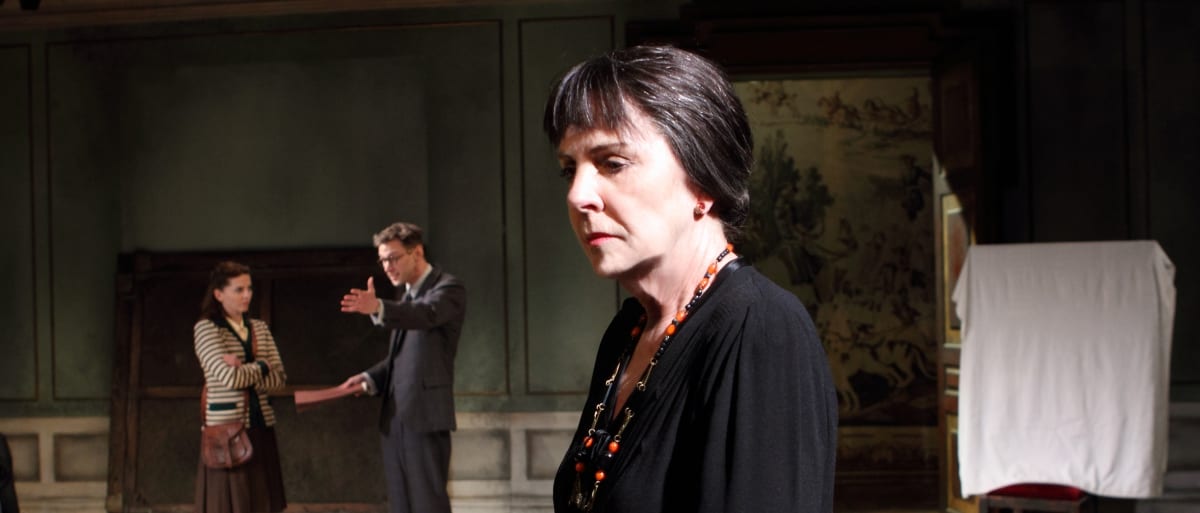The Bay at Nice was first seen as part of a double bill at the National Theatre back in 1986. Written at the end of the Cold War, it is set in Leningrad in 1956 and offers important meditations on the relationship between creativity and freedom on the one hand and the tug between duty and desire on the other. It more than justifies its revival and receives as fine a production as you can imagine; but the fact remains that its original format, as just one half of an evening, confines and restricts the exploration of several important themes. It would have been better if Hare had taken the opportunity of this new production to rewrite and expand it to give air to all the important issues he wishes his characters to discuss.
Valentina Nrovka (Penelope Wilton) is a middle-aged Russian artist who had the opportunity to study with Matisse when young, and after a wild time as a student in Paris, chose to return to the Soviet Union with her infant daughter Sophia (Ophelia Lovibond). This decision determined the course of both their lives and the play hones in on just one episode in the 1950s which dramatizes these consequences. Nrovka is invited to the Hermitage by an ambitious young curator (Martin Hutson) who wants her opinion of a painting attributed to Matisse which has been bequeathed back to the gallery by an exiled Russian count. Her daughter Sophia is there too, in order to enlist her mother’s assistance in gaining her a divorce from her party-member husband at a time when access to divorce was particularly difficult to obtain. Her mother is disinclined to assist. Completing the cast is Peter Linitsky (David Rintoul), who is Sophia’s elderly lover, an ineffectual older man who sees one last chance to find significance and meaning in his life.
The debates and monologues that follow are generally of high quality both as theatre and ideas. Despite his reputation as above all a political writer, Hare is often at his best in writing about artists at work and the social functions of art. What he has to say here not just about Matisse but also the circumstances in which creativity flourishes or withers is thoroughly absorbing and insightful – expository drama at its best. There are also lots of insights into the twists and turns of the art world, akin to the themes developed in Alan Bennett’s ‘A Question of Attribution’ and a keen sense of how wonderful the synergy was between Russia and the ‘avant garde’ in the years either side of the 1917 revolution.

The personal conflicts between mother and daughter are delightfully delivered by Wilton and Lovibond with feisty technique and plenty of pace; but we need more of the backstory to fully grasp why they are so much at odds with one another, and unless you read the programme note it is not clear quite why Soviet divorce law was so weighted against women at this time. In this second strand of more personal themes, there is is a lot of sound and fury that is thus slightly in excess of the overall dramatic rationale provided. What is crucially missing here is any sense of the frustrated professional lives of these two women as painters, and also any detailed, vivid sense of the way in which the Soviet state has imposed heavily on their lives.
What we do have, though, is some peerless acting. Wilton reminds us of how wonderful she was as an actor in Pinter early on in her career – her pauses and pacing are authoritative, and she delivers the one-liners Hare confers on her character with dignified dispatch, while also finding moments of raw emotion and wistful regret when she lets her implacable guard slip. Lovibond is not gratefully costumed and shouts a bit too much, but overall is quite a match for Wilton in the crucial scenes: theirs is an admirable pairing. The two male roles are less well developed, but Rintoul finds pathos as well as slightly absurd comedy in a role that is pure Chekhov. Hutson’s role is more a foil than a fully developed character, but he invests the curator with a kind of fastidious blend of ambition and fear of offending that is highly plausible.
Creative values are excellent throughout: Richard Eyre’s subtle direction keeps the movement fluid in what could easily become a very static play, and Fotini Dimou’s set does wonders with a small space, opening up the angles to everyone in the theatre. You really do believe you are in a grand, faded gallery, with piles of plush and gilded seats, an elaborate parquet floor and a lush eighteenth tapestry leading to the exit all suggesting the artistic treasures nearby. While you have to regret that the author has not chosen to revisit his original text, and expand on its perennially relevant themes, it nevertheless could not be in better hands.

